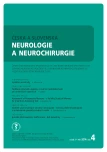The Value of Repeated Non-confirmatory Multiple Sleep Latency Test (MSLT) for the Diagnosis of Narcolepsy
Authors:
K. Šonka; L. Pazderová; J. Bušková; M. Pretl; S. Dostálová; T. Vorlová; J. Piško; E. Maurovich-Horvat; L. Plchová; J. Volná; I. Příhodová; D. Suchá; S. Nevšímalová; D. Kemlink
Authors place of work:
Neurologická klinika a Centrum klinických neurověd, 1. LF UK a VFN v Praze
Published in the journal:
Cesk Slov Neurol N 2014; 77/110(4): 444-448
Category:
Původní práce
Studie vznikla za podpory grantu IGA MZ ČR NT13238– 4/ 2012 a PRVOUK‑ P26/ LF1/ 4.
Summary
Aim:
Narcolepsy is confirmed if the MSLT (Multiple Sleep Latency Test) shows the mean sleep latency of ≤8 min and ≥2 episodes of sleep with early onset of REM sleep. The aim was to assess the value of repeated MSLT in subjects with suspected narcolepsy after the first MSLT failed to confirm narcolepsy.
Patients and methods:
This is a retrospective study of the MSLT results in adult patients examined for narcolepsy at the Sleep and Wake Disorders Center of the Department of Neurology, First Faculty of Medicine and General University Hospital in Prague during a 13-year period. The study analysed 39 adults with suspected narcolepsy who underwent second MSLT in a course of one year after their first MSLT results failed to meet the criteria for narcolepsy, and 42 patients whose initial MSLT was consistent with narcolepsy.
Results:
In 19 patients, the first MSLT was negative, while the second was positive. In 20 patients, both the first and repeated MSLT failed to meet the diagnostic criteria for narcolepsy. These groups differed from one another and from patients diagnosed with the first MSLT in REM sleep latency during nocturnal polysomnography. Sleep latency in the first test is predictive of the outcome of the repeated MSLT (p < 0.001). Sensitivity of one MSLT compared to two is 82.4%, and negative predictive value of the first non-confirmatory test is 48%.
Conclusions:
It is useful to repeat testing in patients with suspected narcolepsy and inconclusive MSLT.
Key words:
narcolepsy – cataplexy – Multiple Sleep Latency Test (MSLT) – REM sleep – sensitivity – negative predictive value
Zdroje
1. American Academy of Sleep Medicine. International classification of sleep disorders, 2nd ed. Diagnostic and coding manual. Westchester (Il); American Academy of Sleep Medicine 2005.
2. Littner MR, Kushida C, Wise M, Davila DG, Morgenthaler T, Lee‑ Chiong T et al. Practice parameters for clinical use of the multiple sleep latency test and the maintenance of wakefulness test. Sleep 2005; 28(1): 113– 121.
3. Johns MW. A new method for measuring daytime sleepiness: the Epworth sleepiness scale. Sleep 1991; 14(6): 540– 545.
4. Arand D, Bonnet M, Hurwitz T, Mitler M, Rosa R, Sangal RB. The clinical use of the MSLT and MWT. Sleep 2005; 28(1): 123– 144.
5. Coelho FM, Georgsson H, Murray BJ. Benefit of repeat multiple sleep latency testing in confirming a possible narcolepsy diagnosis. J Clin Neurophysiol 2011; 28(4): 412– 414. doi: 10.1097/ WNP.0b013e 31822734a3.
6. Chervin RD, Aldrich MS, Pickett R, Guilleminault C. Comparison of the results of the Epworth sleepiness scale and the multiple sleep latency test. J Psychosom Res 1997; 42(2): 145– 155.
7. Hořínek D, Šonka K, Dostálová S, Pretl M, Faltýnová E. Epworth sleepiness scale in sleep apnoea syndrome patients. Neural Network World 2004; 14(1): 67– 72.
8. Aldrich MS, Chervin RD, Malow BA. Value of the multiple sleep latency test (MSLT) for the diagnosis of narcolepsy. Sleep 1997; 20(8): 620– 629.
9. Roth B, Nevšímalová S, Šonka, K, Dočekal P. An alternative to the multiple sleep latency test for determining sleepiness in narcolepsy and hypersomnia: polygraphic score of sleepiness. Sleep 1986; 9(2): 243– 245.
10. Folkerts M, Rosenthal L, Roehrs T, Krstevska S, Murlidhar A, Zorick F et al. The reliability of the diagnostic features in patients with narcolepsy. Biol Psychiatry 1996; 40(3): 208– 214.
11. Dauvilliers Y, Gosselin A, Paquet J, Touchon J, Billiard M, Montplaisir J. Effect of age on MSLT results in patients with narcolepsy‑ cataplexy. Neurology 2004; 62(1): 46– 50.
Štítky
Detská neurológia Neurochirurgia NeurológiaČlánok vyšiel v časopise
Česká a slovenská neurologie a neurochirurgie

2014 Číslo 4
- Metamizol jako analgetikum první volby: kdy, pro koho, jak a proč?
- Kombinace metamizol/paracetamol v léčbě pooperační bolesti u zákroků v rámci jednodenní chirurgie
- Fixní kombinace paracetamol/kodein nabízí synergické analgetické účinky
- Tramadol a paracetamol v tlumení poextrakční bolesti
- Kombinace paracetamolu s kodeinem snižuje pooperační bolest i potřebu záchranné medikace
Najčítanejšie v tomto čísle
- Vyšetření senzitivity
- Spinální arteriovenózní malformace – dvě kazuistiky
- Genetická variabilita u poruchy pozornosti s hyperaktivitou (ADHD)
- Přínos opakování nepotvrzujícího testu mnohočetné latence usnutí (MSLT) pro stanovení diagnózy narkolepsie
